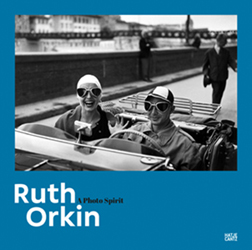It’s safe to say I’ve been more than a little obsessed with the Photo League lately. I’ve been spending time diving into the organization’s history and photographic contributions. (As a starting point, I highly recommend the excellent documentary Ordinary Miracles.) I recently wrote a Binge-Worthy column about Photo League members Morris Engel and Ruth Orkin’s classic first film, The Little Fugitive, and I followed that with a review of Engel’s experimental 1960s counterculture film, I Need A Ride To California, which was released for the first time on DVD this year.
Coincidentally, Ruth Orkin: A Photo Spirit, which reproduces over 200 of Ruth Orkin’s photographs, was just published to celebrate the centennial of her birth in 1921. Accompanying a retrospective exhibit (on view at Fotografiska New York through the end of November), it’s the most definitive collection of her work to date.
The book surveys Orkin’s entire career—tragically cut short by cancer in the 1980s—beginning with her early formative work, made during an epic cross-country bicycle trip from Los Angeles to New York for the 1939 World’s Fair when she was just 18 years old. Orkin had an adventurous heart and a willingness to take risks, and the bicycle trip represents a bold undertaking at the start of a brilliant career.
The appearance of the bicycle trip photos at the beginning led me to expect that the book would be laid out chronologically. However, the next image after that sequence is from 1952. A perfectly composed vertical image shows a solitary figure in silhouette, walking in a downpour, as seen from Orkin’s apartment window. It’s wonderfully atmospheric in a way that’s evocative of film noire. The subsequent photograph, taken from the same apartment during a snowstorm that same year, masterfully portrays a New York winter in bold, abstract, monochromatic strokes.
From there, the book continues to jump around in time. Images are generally grouped together according to a theme or commonality, similar to the way that a photo editor will assemble work for a wide edit before narrowing it down. It’s sprawling and at times a little overwhelming—in the absence of section headers or chapter dividers, the photos just sort of bleed into each other. Images of children at the circus are followed by several taken at a dog show, then several others taken at a parade, and so on. I found the best way to approach the collection was to simply allow yourself to be immersed in it. Approach it like you would a box set of a musical artist that houses every album along with alternate studio takes, B-sides, and excerpts from live performances.
Orkin’s optimism, empathy, and sense of humor shine through in her work. One well-known sequence of six photos, entitled “The Card Players,” dramatizes a card game between three children sitting on a stoop, rendered in soft light and painterly compositions. In the book, the sequence covers four pages. The four photos in the middle of the sequence are printed at half the size of the opening and closing photos, which serve to anchor the story. It’s a highly effective layout. The half-dozen images combine to tell a short story—or perhaps more accurately, play out like a short film—and build to a satisfying resolution as the little girl in the center of the frame smiles victoriously. The entire sequence was included in MoMA’s legendary 1955 exhibition The Family of Man, curated by Edward Steichen, who had by then become a huge supporter of her work.

One of the great pleasures of retrospectives is that you inevitably discover something new. There is no shortage of such discoveries in these pages. Adding further value to the book, excerpts from Orkin’s unfinished autobiography are printed at the end. The selections give a great deal of insight into her approach to making pictures and her experience as one of the few female photographers in a very male-dominated industry. Her diary excerpts regarding the making of the instantly iconic “American Girl in Italy,” are reprinted at the end as well.

Although it could be a little more accessible to the uninitiated, it’s a gorgeous collection nevertheless and a highly valuable book that should hold immense appeal for photography lovers. And it should further cement Ruth Orkin’s place in the pantheon of great 20th Century photographers.
Ruth Orkin: A Photo Spirit. Edited by Nadine Barth and Mary Engel. Text by Kristen Gresh and Ruth Orkin. Hatje Cantz, 2021. 240 pages. Hardcover.
